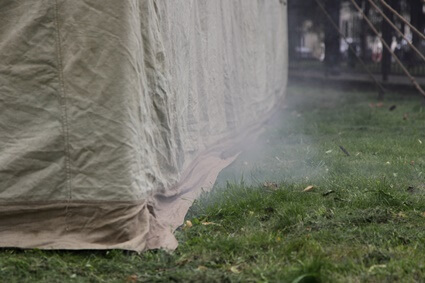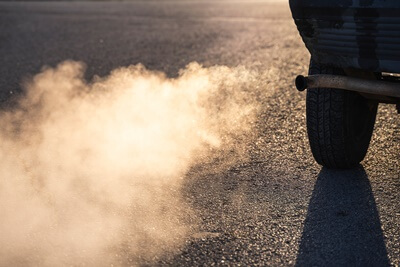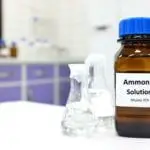Rats are resilient pests, capable of adapting to poison and learning to avoid traps.
In light of this, you may be looking for more creative ways to exterminate rats in your home. Some people even consider using carbon monoxide to get rid of a rat problem.
Carbon monoxide can be used to control burrowing rodents, like rats. This is done using a carbon monoxide pest control device, which is a machine that dispenses carbon monoxide through a long tube.
Carbon monoxide can kill rats, but the process has risks.
It is best to leave the application of carbon monoxide to pest control services. This is also true if you’ve considered using exhaust fumes to kill rats, whether from cars or other sources.
Can Rats Die From Carbon Monoxide
Carbon monoxide poisoning works similarly in humans as it does in rodents.
Pest control services use carbon monoxide, but not as much as other methods, like traps and poison. Even the USDA Wildlife Services uses carbon monoxide in wildlife control.
It’s sometimes considered a more humane alternative to other pest control methods.
In laboratory experiments, scientists often use carbon dioxide, which is similar to carbon monoxide, to euthanize laboratory rodents. However, some studies dispute whether it’s humane.
According to Biology Letters, rats may prefer looking at a bright light to staying in a room with carbon dioxide. So, carbon dioxide, as well as carbon monoxide, may be alarming and frightening to rats, making it a less gentle way to euthanize them.
Carbon monoxide should only be used for rodent control in large, open areas. In some areas, by law, you may not be allowed to use CO for rodent control if you’re too close to an establishment.
Carbon Monoxide Machine To Kill Rats
Some commercially available machines dispense carbon monoxide specifically made for rodent control.
These are sometimes referred to as ‘carbon monoxide pest control devices.’ These include the Gopher X Extermination Machine and the Cheetah Rodent Control Machine.
Depending on your location, you may have to abide by certain laws when using this device. Some locations only require you to use protective eyewear and only use the device away from establishments.
However, some locations may not allow you to use this machine. Always check local policies before purchasing and using a carbon monoxide machine.
Gassing Rats with Carbon Monoxide
Carbon monoxide kills rats because it binds with the blood.
Blood needs oxygen, which contains two oxygen molecules. However, blood can’t distinguish between oxygen and carbon monoxide.
After all, carbon monoxide also contains an oxygen molecule. Since carbon monoxide only contains one oxygen molecule, while oxygen gas contains two, this becomes deadly.
As the blood absorbs carbon monoxide, it won’t get enough oxygen. It’s also absorbing carbon, which the body wants to remove.
As the body takes in more carbon, all while running out of oxygen, the body starts to shut down.
Carbon Monoxide
Carbon monoxide is a colorless, odorless, and tasteless gas. After all, it’s a gas used in many industries, including creating fragrances, medicine, and fuels.
However, the most common source of carbon monoxide is thermal combustion, which is when fuel is burned for energy. Vehicle emission is a common source of carbon monoxide.
In small amounts, carbon monoxide is tolerated by the body. However, when there’s a concentration of carbon monoxide in an area, it can lead to carbon monoxide poisoning.
It’s important to work in a well-ventilated area when dealing with sources of carbon monoxide.

Carbon Monoxide Poisoning
Carbon monoxide poisoning happens when too much carbon monoxide is in the blood. When it builds up, the blood can’t deliver oxygen to various body parts.
Carbon monoxide used to be more common before we understood how it interacted with the body.
However, there are still cases of CO poisoning. According to Human and Experimental Toxicology, there are about 137 cases of CO poisoning per year globally.
Symptoms of carbon monoxide poisoning include:
- Headaches
- Weakness
- Dizziness
- Nausea
- Vomiting
- Confusion
- Blurred vision
- Loss of consciousness
Carbon monoxide poisoning is dangerous for people who have impaired consciousness, like those who are asleep or intoxicated.
People may continue breathing in the gas without noticing the adverse effects. With sufficient exposure, carbon monoxide poisoning can cause:
- Permanent brain damage
- Organ damage
- Fetal death or miscarriage
- Death
Killing Rats With Exhaust
It’s technically possible to kill rodents using exhaust fumes.
Specifically, some carbon monoxide pest control devices hook up to your car’s exhaust. However, aside from using a machine, getting the gas to where you need it to go can be difficult.
There are other sources of exhaust that can also deliver carbon monoxide, including:
- Lawnmowers
- Power washers
- Back-up generators
- Other vehicles
Carbon monoxide is toxic to humans. Car exhaust fumes don’t just contain carbon monoxide. There are many other gasses and particles found in the exhaust that is harmful to your health, including:
- Particulate matter: Very fine particles measuring less than 10th the diameter of human hair. Due to their size, they can penetrate deep into the lungs.
- Volatile organic compounds: Pollutants that react with sunlight to form smog.
- Nitrogen oxides: Forms ozone and particulate matter.
- Carbon monoxide: Blocks oxygen from reaching vital organs.
- Sulfur dioxide: Forms particulate matter and is a common cause of asthma.
Additionally, the exhaust also contains various greenhouse gasses.
In fact, exhaust fumes are one of the top contributors to global warming. Vehicle emissions account for over 1/5th of the total global warming pollution in the United States.
How Long Does It Take For Carbon Monoxide To Kill Rats
Carbon monoxide is a common method for euthanizing rodents in laboratory settings. In these cases, they can die in just 40 seconds.
Using CO as a pest control method may take longer than 40 seconds for the rats to die. However, the effects should be faster than most pest control methods.
If you use a carbon monoxide machine, the entire process should take around 1-2 hours. This will include setting up the machine and applying the gas to the whole area.







